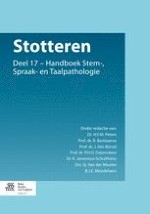Gepubliceerd in:
2014 | OriginalPaper | Hoofdstuk
Diagnostiek bij volwassen stotteraars
november 2005
Samenvatting
Diagnostiek en behandeling van stotteraars worden in sterke mate bepaald door het theoretisch concept waar de clinicus van uitgaat in zijn benadering van het stotterprobleem.
